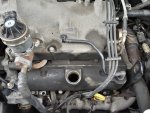Im pretty sure shops dont heat up an engine before a compression test. The purpose is to find one or more cylinders that show a significantly lower reading.
There are other chemical tests that do not require a vacuum source, they use a rubber squeeze bulb.
It was in the instructions that came with the gauge. I believe that is due to a warm engine may expand the leak therefore show a lower reading which might not be seen when the engine is cold.
I tried a block test with the chemical using a turkey baster bulb to draw air through the chemical. It passed so I was going to test each cylinder to see if it is a head gasket leak.
The only other test I may have failed that may point to a head gasket leak is when I did the coolant pressure test with the engine on revving the engine. The gauge moved down fast when I stepped on the gas and then shot back up higher psi than before when I let off the gas. I saw a video of a guy on youtube doing a test that way and his gauge did not move. They then celebrated that it was not a head gasket leak. So I am thinking I do have a head gasket leak from that and coolant being forced out of the over flow.
But not sure since I never did any of this before. I do not want to waste $1200+ fixing the head gasket on top of all the money I spent already with crooked mechanics trying to troubleshoot this.


